Abdominal Muscles

The strength and function of the abdominal muscles protect the core’s ability to adapt with pregnancy, while also preventing back and pelvic pain.
Separation of these muscles is very common during pregnancy (diastasis recti), and it may take a few weeks to a few months for the muscles to return to their pre-pregnancy state.
Fortunately, diastasis recti is not considered dangerous to the abdomen, but it may lead to back and pelvic instability, causing pain.
HCPs may be able to provide recommendations that could prevent separation (or further separation) while improving core stability during and after pregnancy. It is also important that women follow the recommendations provided by medical professionals regarding this separation in the postpartum period, so they can avoid serious injury.
Women should direct all questions and concerns they have regarding their abdominal and core muscles during and after pregnancy to their HCP.
Background
The abdominal muscles support the abdominal organs and the spine; when these muscles contract, they support core bending and twisting. They also hold the spine stable to stand upright. This is called “core stability".
Pregnancy
Progesterone and relaxin affect the connective tissue of the abdominal muscles and promote gradual (but substantial) stretching as pregnancy progresses. Both strips of this connective tissue slowly drift apart to allow for expansion.
During pregnancy, the waist can increase up to 50 cm and the recti abdominis muscle can be stretched up to 20 cm.
When the abdominal muscles stretch to accommodate the enlarging uterus, they weaken and become less effective. This causes muscle fatigue and the spine is left to support the increased weight of the torso, which can cause back pain.

Further, depending on the severity of the degree of separation and length, the function of the abdominal muscles can change, and pelvic instability occurs. And with loosening of the pelvic ligaments due to hormones, this can play a major role in developing pelvic girdle pain.
This change in function, length, and angle is why abdominal crunches and other abdominal exercises are not recommended during pregnancy, because these exercises do not work the way they would prior to pregnancy, and may further damage and weaken the muscles.
It is also recommended that women do not lie flat on their backs later in pregnancy; the weight of the uterus could block major blood vessels (read more).
Normally, separation of the abdominal muscles would also make breathing more difficult due to the loss of strength, but in pregnancy, this has no major effect because the diaphragm moves up about 4 to 5 centimeters, making up for this loss of strength.
It is possible these muscle changes can completely reverse by the first month after delivery, but most women have separation of the muscles for a few weeks to a few months longer.
Diastasis Recti
In women with diastasis recti, the two parallel bands of connective tissue separate to an abnormal distance, and some of this distance can remain months after delivery.
Diastasis recti might cause a bulge near the belly button where the two muscles separate, which is more noticeable when a woman attempts to sit up or perform an abdominal exercise (postpartum). It is usually not noticeable when the woman is standing (but can be).
Diastasis recti can force a woman to change her posture and even hinder routine daily activities due to loss of function and strength; this loss could potentially cause lasting lower back pain, although this is debated.
It is very difficult to determine the prevalence of this condition, or to the degree women experience separation, as there is no universal agreement about the condition’s definition or cut-off values. Further, different forms of measurement and populations of women are often used across studies.

However, the condition is not dangerous, and HCPs can work with women by recommending various exercises and physical therapy to attempt to return the muscles to a more normal distance.
Action
As the uterus begins to grow out of the pelvis, women should avoid abdominal crunches and other related exercises during pregnancy to prevent abnormal stretching and further loss of strength.
As pregnancy progresses, women should roll to the side, bend the knees, and push up to get off the floor or bed to avoid overstretching, as well as a similar process to lie down.
Heavy lifting should be avoided whenever possible, although the specific weight cut-off is not known. One study showed that women who performed “heavy lifting” 20 times a week or more were more likely to develop diastasis recti. When lifting is necessary, women should bend their knees and keep their backs straight, hold the object close to their body, and avoid twisting the back to lift.
If the “object” is a child, women should use caution to protect themselves as much as possible from injury. Women should also bend the knees to lower an object or child to the ground instead of bending the back.
It has been suggested that women should “brace” their abdominal muscles by contracting the muscles or using their hands when coughing, laughing, or sneezing to prevent any gap from getting worse. It is unclear how effective this is, but it unlikely to be harmful.
A physical therapist can help determine exercises that may close some of the separation after an HCP has given clearance. Attempting abdominal exercises too soon after delivery can further weaken and separate the muscles.
If diastasis recti is severe, which may include the presence of a hernia, surgery may be recommended to repair the muscle separation, but is generally performed after the woman is done having children.